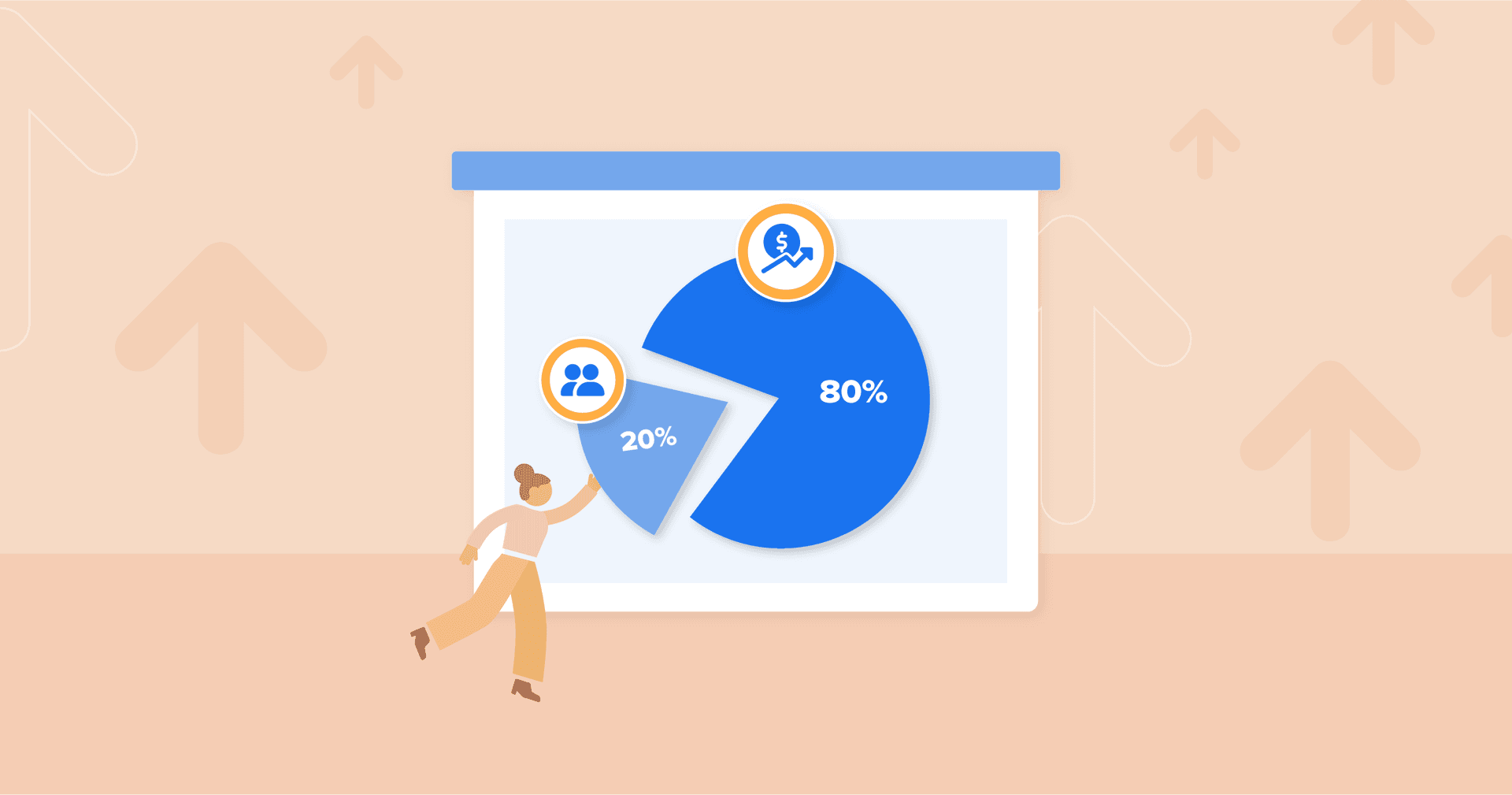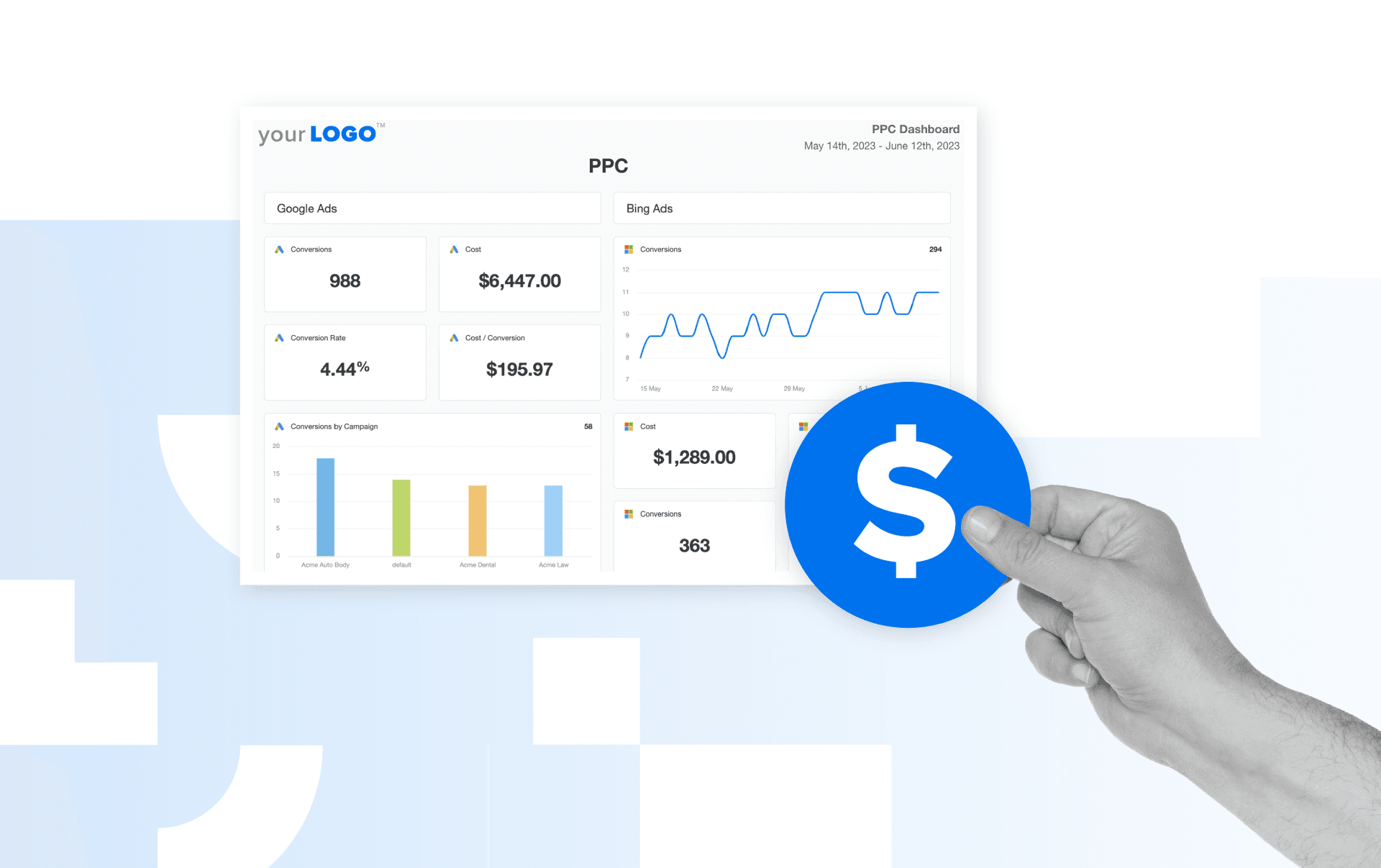Table of Contents
QUICK SUMMARY:
Agency pricing refers to the structured approach a marketing or advertising agency employs to determine the cost of its services. This involves strategies like hourly rates, project-based fees, retainer agreements, and value-based pricing. These models consider factors such as task complexity, expertise, resources, and client outcomes. This guide covers various agency pricing strategies, optimal times for client billing, and tips for maximizing profitability.
One of the most challenging parts of building and scaling an agency? Nailing down the right pricing model that works for both you and your clients. It needs to strike that perfect balance between profitability and value, all while still keeping your services competitive.
While there’s no universal formula for pricing success, having a deep understanding of how to charge fairly without compromising quality is key. After all, you don’t want to end up in a situation where you’re working around the clock but still struggling to reach your desired profit margin.
If it sounds like a lot, don’t worry–you’ve come to the right place. Read this guide to agency pricing, take a look at your books, and see if your agency needs a little price adjustment! It may well be worth your dime and time.
Major factors that contribute to digital marketing agency pricing
Effective pricing starts with clarity. The most successful agencies know exactly which factors influence their rates and use that insight to strategically position their value. Here’s what truly impacts how much you charge (and why it matters).
Factor | Description |
|---|---|
Scope of work | More moving parts—like multiple channels or deliverables—mean more work, which drives pricing higher. |
Experience and expertise | Agencies with proven track records, niche specialization, or advanced capabilities often command higher rates. |
Team composition | Senior strategists, designers, and technical specialists typically bill at higher rates than junior team members. |
Tools and technology | The software, analytics platforms, or paid subscriptions required to deliver results can influence pricing. |
Client size and industry | Larger clients or those in competitive industries (like finance or healthcare) often require more time and resources. |
Geographic location | Rates vary by region—agencies in major cities generally charge more due to higher operating costs. |
Contract length and commitment | Long-term retainers may include discounted rates compared to one-off or short-term projects. |
Ultimately, understanding these factors helps your agency set pricing that’s both competitive and reflective of the true value you deliver to clients.
How much does digital marketing cost?
When it comes to pricing your services, there’s no universal formula. Rates will vary widely depending on your service mix, deliverables, target market, and experience level. Here are some general estimates to give you an idea of what clients typically invest.
1. SEO
SEO pricing depends on the size of the site, the client’s goals, and the overall competitiveness of their niche. Here’s what costs may look like based on agency size:
Freelancers / small agencies: $500–$2,000 per month
Mid-sized agencies: $2,000–$5,000 per month
Enterprise or national campaigns: $5,000–$20,000+ per month
2. PPC
PPC management requires ongoing optimization, keyword testing, and performance reporting. Agencies often charge a percentage of ad spend or a flat monthly retainer. Here’s how that might break down:
Management fees: 10%–30% of monthly ad spend
Typical campaign budgets: $1,000–$10,000+ per month (plus ad spend)
3. Social media marketing
Social media services can range from basic posting and community management to full-scale creative strategy and paid campaigns. Pricing often depends on platform count, content volume, and ad spend. For instance, this could look like:
Basic social media management (1–2 platforms): $500–$1,500 per month
Full-service campaigns (multi-platform, content + ads): $2,000–$10,000+ per month
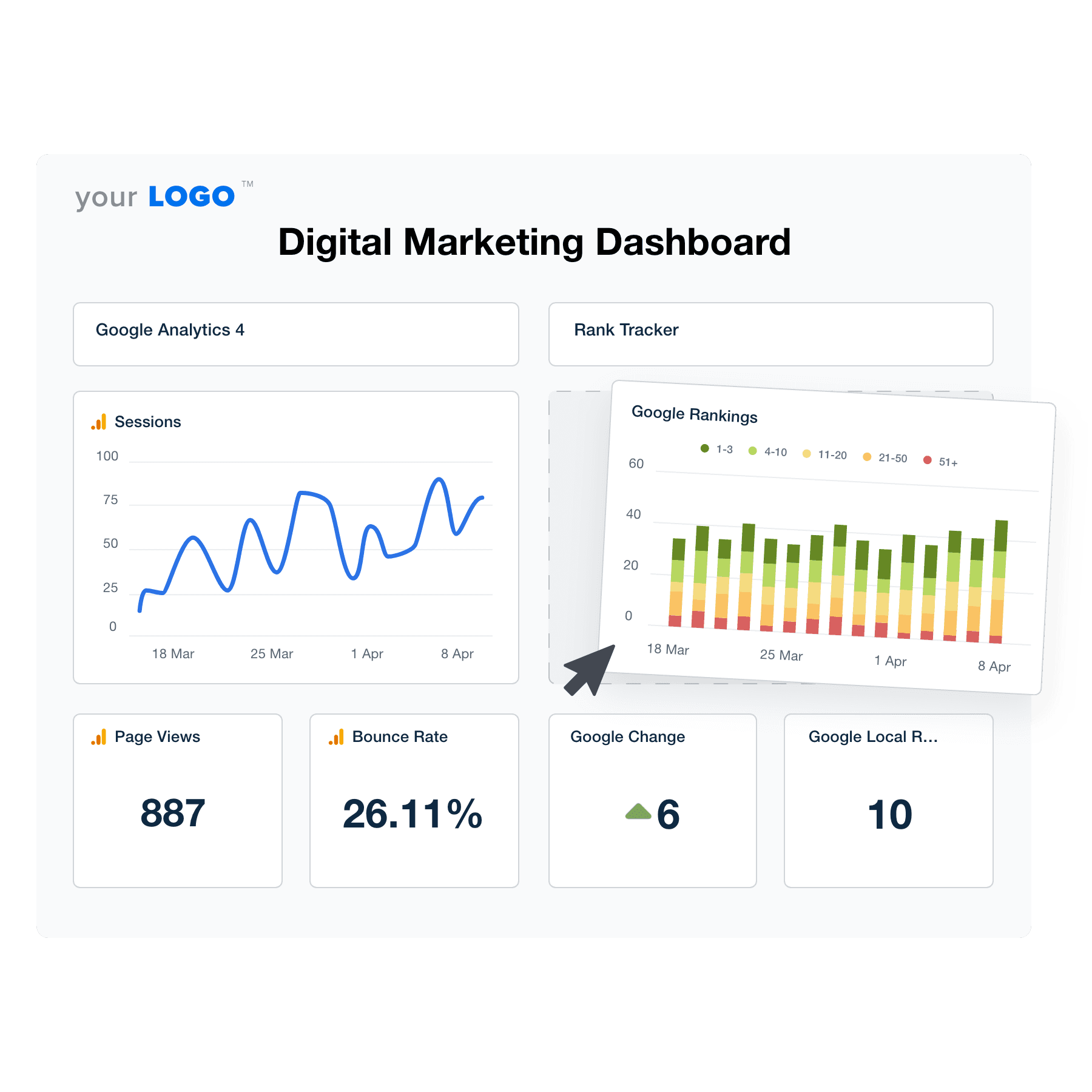
Consolidate data across 80+ platforms with just one tool. Create white-label reports, access real-time dashboards, and more! Try AgencyAnalytics, free for 14 days.
4. Email marketing
Email remains a high-ROI channel, but costs vary depending on the level of strategy, automation, and design support you provide. This may look something like:
Setup & strategy (one-time): $500–$2,000
Ongoing campaigns: $500–$3,000+ per month
Per email (project-based): $100–$500 each
5. Full-service digital marketing packages
For agencies offering end-to-end strategy and execution, full-service retainers combine multiple channels into one streamlined package. Here’s a rough breakdown:
Smaller clients / local businesses: $2,500–$5,000 per month
Mid-sized companies: $5,000–$15,000 per month
Enterprise clients: $20,000–$100,000+ per month
Agency pricing models
Pricing is often the difference between a profitable, scalable agency and one that struggles to get by each month. To help you make an informed decision, we’ll cover a range of pricing models (along with pros and cons).
Hourly rate model
When you’re starting out, hourly pricing is often the way to get your foot in the door. Clients instantly understand what they’re paying for, it’s transparent, and it feels like a low-risk way to start working together.
Hourly is the easiest contract to sign, takes the least marketing skill, and the work stops immediately when you're off the clock. It's far less stressful. And you're held less responsible for results. However, you're often competing against freelancers, some whom are overseas, and some who are desperate for any work. The pricing can lead to a race to the bottom in order to win a contract.
Brian Robben, CEO, Robben Media
Types of hourly rates
There are two types of hourly pricing rates to consider–let’s explore them in detail.
Blended rate
A blended rate is a single, uniform hourly (or daily) rate that applies to all team members, regardless of their individual roles or experience levels.
For instance, instead of charging different rates for junior designers, senior strategists, and account managers, your agency might charge a flat rate—say $500 per day—for any work performed by the team. As a quick reference:
Blended hourly rate = (Total cost of all employees’ hours) ÷ (Total number of hours worked)
Say a senior developer earns $120/hour and is expected to work 10 hours. On the other hand, a junior designer earns $80/hour and will likely contribute 20 hours. In this case, (120 × 10) + (80 × 20) = 2800, and 2800 ÷ (10 + 20) = 93.33. So, the blended hourly rate would be $93/hour.
Specialist rate
A specialist rate involves charging different hourly rates for each team member based on their role, experience, and contribution to the project. This means that senior employees may have higher rates than junior team members. Based on this:
Specialist hourly rate = (Hourly rate of each employee × Their hours worked)
Say a senior developer charges $120/hour and is expected to work 15 hours ($1800 total). Additionally, a junior designer charges $80/hour and will contribute approximately 25 hours ($2000 total). In this case, the client pays $3,800 based on the individual rates and expected hours of each specialist.
The pros and cons of hourly rates
As with all things, there are a few ups and downs to consider.
Pros | Cons |
|---|---|
Easy to reference–quickly send quotes and share how much a project costs upfront. | Risk of financial loss if your agency doesn’t correctly estimate project completion times. |
Helps in defining which types of projects or clients to pursue. | Can lead to inconsistent income if client workloads fluctuate month to month. |
Gives your agency more autonomy over how time is spent. | May be difficult to estimate a completion time for newly offered services. |
Agency Tip: In addition to the actual work, consider extra labor costs, such as admin duties and project management. To account for this, add a small margin to your hourly rate. That way, your agency’s compensation will also include behind-the-scenes tasks that keep projects running smoothly.

Include an automatic PPC markup in client reports to share upfront agency costs without confusion. Try it in AgencyAnalytics–start your free 14-day trial today!
Project-based pricing model
Another common type of pricing model is charging a fixed amount for each project.
To set a project-based fee, agencies typically estimate the total labor hours and associated costs (e.g., software subscriptions). Additionally, a profit margin is included to account for any unexpected developments (such as project scope changes, client revisions, or delays).
The pros and cons of project-based pricing
Before deciding on this fixed price model, consider the following factors.
Pros | Cons |
|---|---|
Works well for projects with clearly defined deliverables. | Difficult to accurately estimate costs for new or complex projects. |
Income isn’t directly tied to time, making it more scalable than hourly billing. | If a project takes longer than expected, your agency still earns the same amount. |
Encourages agencies to be efficient and finish projects on time. | May lead to scope creep if deliverables aren’t managed properly. |
Agency Tip: To minimize risk, consider starting with a few projects billed hourly. Gather accurate data on time and resource allocation. Then, use this internal market research to inform your project-based pricing structure.
Performance-based model
In this pricing model, clients are charged based on achieving specific outcomes or targets. This makes it ideal for agencies that can directly influence tangible results, such as lead generation, sales, or online advertising performance. It also ensures both the agency and client are motivated by the same outcomes, which keeps everyone on the same page.
In many cases, the pricing structure isn’t entirely performance-based (despite the name). Instead, it includes a base or upfront fee to cover initial costs, along with a performance fee tied to results (e.g., the number of leads generated or sales achieved).
Examples of performance-based pricing
To illustrate performance-based pricing, here are some of the most common approaches:
CPM (Cost Per Mille): Your agency charges clients based on impressions, typically per 1,000 ad views. This model works best for brand awareness campaigns or clients focused on reach and visibility.
CPL (Cost Per Lead): You’re paid a fixed rate for every qualified lead generated, such as form fills, demo requests, or newsletter sign-ups. This model is ideal for agencies running lead gen campaigns for B2B or service-based clients.
CPV (Cost Per View): Your agency earns revenue each time a video ad is viewed (e.g., on YouTube or social platforms). It’s great for video-first campaigns where engagement and reach are primary KPIs.
CPC (Cost Per Click): Clients pay for each click that drives traffic to their site or landing page. It’s one of the most widely used pricing methods in PPC and social ad management because it’s easy to track.
CPA (Cost Per Acquisition): Your agency is compensated only when a specific action or conversion happens. This is one of the most results-oriented structures, but it also carries more risk, since payment depends entirely on outcomes.
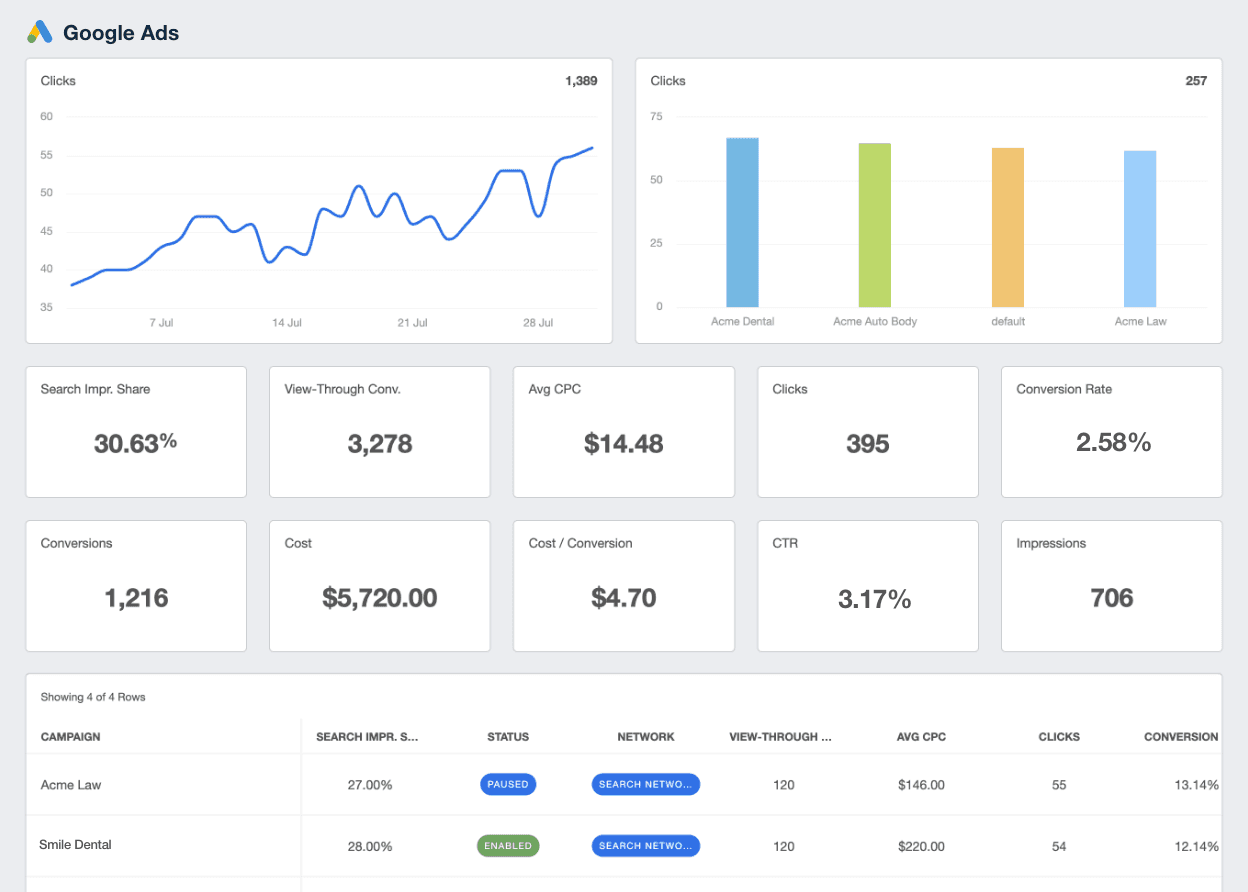
Easily monitor real-time performance and share accurate data with clients. Create customizable marketing dashboards in AgencyAnalytics–it’s free for 14 days.
Parameters needed for performance-based pricing
In order to charge based on performance, your agency needs to establish a few key parameters at the start of the client relationship, including:
Relevant conversion metrics: Define what success looks like (e.g., leads, sales, downloads, sign-ups).
The value of each conversion: Agree on what each action is worth to the client.
How conversions will be tracked and shared: Ensure both parties have visibility into data and reporting.
The performance payout timeline: Set clear terms for when and how payments are issued.
By defining these parameters early, you’ll build transparency, set realistic expectations, and protect your agency’s profitability.
The pros and cons of performance-based pricing
For more context, let’s explore the benefits and drawbacks of performance-based pricing.
Pros | Cons |
|---|---|
Easier to sell since the agency shares some of the risk. | May create tension if performance expectations aren’t clearly defined. |
Demonstrates that you stand behind the effectiveness of your service offerings. | Could strain cash flow if results take time to materialize. |
Builds client trust and shows commitment to shared success. | Requires precise attribution, which can be difficult if multiple vendors are involved. |
Agency Tip: Use performance-based pricing for clients with the experience and infrastructure to maintain consistent results. Confirm they can handle their part effectively to prevent your agency’s success—and payments—from being derailed by external factors.
Retainer pricing
Charging clients a retainer offers significantly more scalability than other models. It provides predictable income while giving clients consistent access to your agency’s expertise.
It’s also a natural next step for agencies that start with hourly or project-based pricing. Once you’ve proven your value and built trust, it’s easier to transition clients into a retainer for ongoing services.
We don't have any specific pre-packaged pricing. Rather, we spend time recommending services that will maximize ROI and deliver results. Typically, we generate proposals with fixed monthly fees for services delivered. This allows a mutual partnership with our clients and assures them that they can reach out frequently without feeling as though they're being billed for it.
Steve Ryan, Founder & CEO, RyTech
A retainer model can come in two forms:
A predetermined amount of time: In this case, your agency offers a set number of billable hours for services. This fixed fee works well for clients with ongoing needs that exhibit some variability (e.g., website maintenance tasks).
A predetermined set of deliverables: This approach focuses on specific outputs or tasks to be completed within a given period (e.g., monthly content creation). It’s ideal for clients with clearly defined, recurring deliverables.
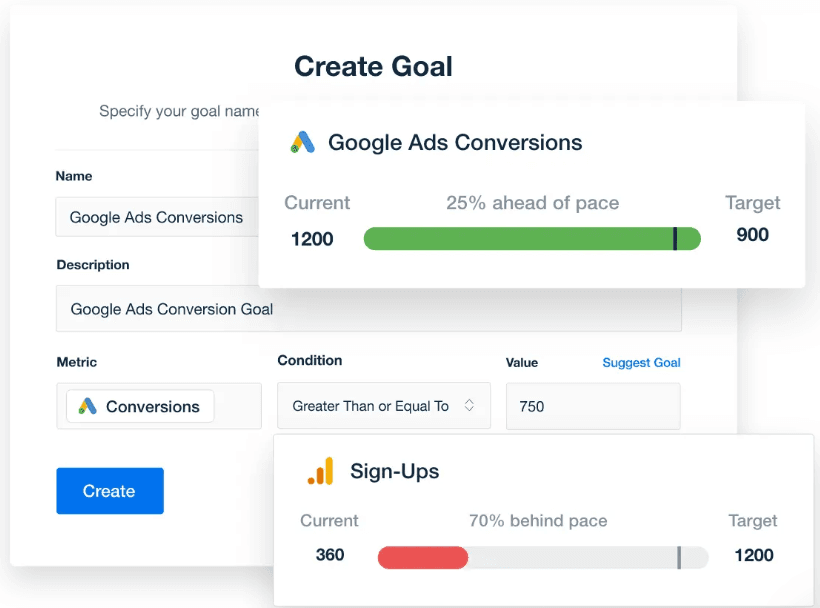
Don’t lose track of your client’s goal progress, especially when pricing is at stake. Keep tabs on real-time campaign performance in AgencyAnalytics–it’s free for 14 days.
Pros and cons of retainer-based pricing
Thinking about this option? Let’s dig a little deeper to understand the ins and outs of retainer-based pricing.
Pros | Cons |
|---|---|
Monthly income is predictable–ideal for financial stability. | Challenging to convince potential clients who may not be familiar with your services. |
Fees are usually paid upfront on a specific date, which minimizes risk. | May not work well for clients with ad-hoc requests or lighter deliverables. |
Ideal for building long-term client relationships and getting referrals. | Some clients may not want to be ‘locked in’ for a given time period. |
Agency Tip: If your retainer is time-based, your client is essentially prepaying for a set number of hours at your hourly rate. When setting up this type of agreement, clearly define whether unused hours expire at the end of each month or can roll over into the next period.
Value-based pricing
The final—and often most strategic—type of pricing model is value-based pricing. With this approach, your revenue is completely independent of hours worked, making it one of the most scalable pricing models. Instead of trading time for money, you’re rewarded for the impact and outcomes you create.
If you’re leaning towards a value-based pricing model, you’ll need to understand:
Where your clients are now.
Where they want to be.
What achieving that goal is worth to the client’s business.
For example, if you can demonstrate that your strategy could boost the client’s revenue by $1M, they’ll care far less about the number of hours it takes. Instead, they’re more likely to focus on the perceived value and solid agency performance.
Pros and cons of a value-based model
Before deciding on this model, consider the following points.
Pros | Cons |
|---|---|
Clients are more willing to pay upfront when they see clear value in your services. | Some clients may hesitate to invest upfront if ROI isn’t immediately clear. |
Works well for clients with long-term business goals, such as scaling revenue. | Harder to quantify value when results aren’t directly tied to measurable outcomes. |
Less time-sensitive than other models–easier to focus on results over hours. | Clients may grow impatient if results take longer than expected. |
Mixed rates
Of course, you don’t need to pick only one pricing model. You always have the option to offer several options that suit each client's needs.
Our pricing models are tailored to meet the needs of different clients. By having flexibility within our pricing capabilities, we’re better able to customize our rates based on individual needs. This empowers our team to focus on areas that ensure client success, rather than a "one-size-fits-all" approach.
Ashley Sterling, Director of Operations & Client Success, Loop Marketing
For example, your agency might charge a project-based fee for an initial website redesign. Once that’s out of the way, it makes sense to transition to a monthly retainer for ongoing SEO services.
Similarly, you might combine a base management fee with a performance-based bonus for paid advertising campaigns. Or, you could implement tiered pricing, where clients choose from different levels of service, each offering a higher degree of support, deliverables, or reporting depth.
By combining models thoughtfully, you’ll balance client expectations with predictable, sustainable revenue for your agency.
When to charge your clients
Knowing when to charge your clients is just as important as knowing how much. Setting clear payment milestones helps maintain healthy cash flow and sets the right expectations from the start. Here’s how agencies typically structure their billing:
Charging upfront
Charging clients upfront is one of the most effective ways to maintain positive cash flow. This model works best for project-based, retainer, or value-based pricing structures, where the scope and deliverables are clearly defined.
If you charge hourly, upfront billing typically isn’t feasible (since that would shift it into a time-based retainer). Instead, you’ll need to agree on a regular payment frequency.
50% upfront, 50% on completion
Splitting payments—often 50% upfront and 50% upon completion—is a popular middle ground that benefits both your agency and the client. The initial deposit secures your time and covers startup expenses, while the final payment rewards successful delivery.
This cost structure is especially common for project-based or value-based pricing, where work is done in defined phases. It also signals fairness: The client sees you share accountability for delivering results, and your agency ensures coverage for early costs.
Milestone-based payments
Milestone-based billing involves charging at key project stages—such as strategy approval, design delivery, or campaign launch. Plus, it keeps payments aligned with progress and helps your agency maintain steady cash flow during longer engagements.
Impress clients and save hours with custom, automated reporting.
Join 7,000+ agencies that create reports in under 30 minutes per client using AgencyAnalytics. Get started for free. No credit card required.
On completion
Charging upon project completion can be appealing for new agencies looking to build credibility. It shows confidence in your ability to deliver and can be an effective sales tool when pitching new clients.
However, this model carries more risk—delayed payments, scope creep, or clients backing out after delivery are common challenges. It’s important to use contracts and milestones to safeguard your agency’s efforts.
Summary: Agency pricing models
Choosing the right pricing model is one of the most important strategic decisions your agency can make. It affects how you scale, how clients perceive your value, and ultimately, how profitable you become.
There’s no single “perfect” structure. The best pricing strategy depends on your goals, clients, and services:
Hourly pricing: Offers flexibility and simplicity but can limit sustainable growth as your agency scales.
Project-based pricing: Works best for clearly defined deliverables with set timelines.
Retainers: Provide predictable, recurring revenue and foster long-term partnerships.
Performance-based pricing: Rewards measurable results and builds client trust—but requires clear attribution.
Value-based pricing: Shifts the focus from time spent to the results and impact your agency delivers.
Mixed model approach: Combining multiple pricing structures to balance stability and profitability.
Regardless of the pricing model, you’ll need a reliable way to show tangible results and justify the cost of your services. That’s where a platform like AgencyAnalytics comes in. From tracking campaign performance to visualizing the impact of your work, this tool helps your agency demonstrate value every single month.
Streamline agency operations, track profitability, and provide maximum value to your clients. Try AgencyAnalytics free for 14 days–no credit card required.

Written by
Peter Foy is a content marketer with a focus on SaaS companies. Based in Toronto, when he’s not writing he’s usually studying data science and machine learning.
Read more posts by Peter FoySee how 7,000+ marketing agencies help clients win
Free 14-day trial. No credit card required.




